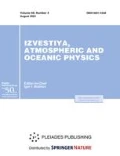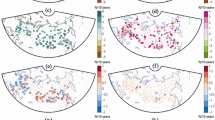Abstract—
A regional system of a short-term forecast of hazardous convective phenomena within WRF-ARW is described. It is shown that major maxima of errors in prognostic temperature and vertical velocity correlate with intense convective events, which indicates the need for additional verification procedures. A new method is proposed for forecasting hazardous convective events based on analyzing the simulated spatiotemporal distributions of the radar reflectivity of an event and comparing them with characteristic parameters (the duration, area, and maximum radar reflectivity) of intense convective events. Threshold values of the area and duration of the event are selected using field observations of powerful convective clouds, while the threshold of the maximum radar reflectivity in the vertical column is tailored for regional features. The method is verified against World-Wide Lightning Location Network (WWLLN) data and ground-based field measurements of the quasi-static electric field. It is shown that, for selected thresholds of duration (20 min) and area (50 km2), the optimal threshold of maximum radar reflectivity for Nizhny Novgorod oblast is 55 dBZ, in which case the Pierce skill score and the Heidke skill score take values of 0.61 and 0.62, respectively.



Similar content being viewed by others
REFERENCES
A. Chernokulsky, F. Kozlov, O. Zolina, et al., “Observed changes in convective and stratiform precipitation in Northern Eurasia over the last five decades,” Environ. Res. Lett. 14 (4), 045001 (2019).
A. V. Chernokulsky, M. V. Kurgansky, and I. I. Mokhov, “Analysis of changes in tornadogenesis conditions over Northern Eurasia based on a simple index of atmospheric convective instability,” Dokl. Earth Sci. 477 (2), 1504–1509 (2017).
V. I. Bychkova, V. L. Perov, and G. K. Rubinshtein, “Numerical simulation of snowstorm emergence and development with the WRF-ARW model,” Tr. Gidromettsentra Rossii, 353, 46–62 (2015).
The Weather Research and Forecasting Model. www. mmm.ucar.edu/weather-research-and-forecasting-model
N. F. Vel’tishchev and V. D. Zhupanov, “Experiments on numerical modeling of intense convection,” Russ. Meteorol. Hydrol. 33 (9), 560–569 (2008).
N. F. Vel’tishchev and V. D. Zhupanov, “Numerical weather forecasting based on WRF-ARW and WRF-NMM non-hydrostatic models for common-use,” in 80th Anniversary of the Hydrometcenter of Russia (Triada Ltd, Moscow, 2010) [in Russian], pp. 94–135.
N. F. Vel’tishchev, V. D. Zhupanov, and Yu. B. Pavlyukov, “Short-range forecast of heavy precipitation and strong wind using the convection-allowing WRF models,” Russ. Meteorol. Hydrol. 36 (1), 1–10 (2011).
L. I. Kizhner, D. P. Nakhtigalova, and A. A. Bart, “The use of the prognostic WRF model for weather forecasting in the Tomsk region,” Vestn. Tomsk. Gos. Univ., No. 358, 219–224 (2012).
Yu. V. Martynova, R. B. Zaripov, V. N. Krupchatnikov, and A. P. Petrov, “Estimation of the quality of atmospheric dynamics forecasting in the Siberian region using the WRF-ARW mesoscale model,” Russ. Meteorol. Hydrol., No. 7, 39 (2014).
I. M. Gubenko and K. G. Rubinshtein, “Analysis of the results of thunderstorm forecasting based on atmospheric instability indices using the WRF-ARW numerical model data,” Russ. Meteorol. Hydrol. 40 (1), 16–24 (2015).
S. O. Dementyeva, N. V. Ilin, and E. A. Mareev, “Calculation of the Lightning Potential Index and electric field in numerical weather prediction models”, Izv., Atmos. Ocean. Phys. 51 (2), 186–192 (2015).
A. O. Fierro, E. R. Mansell, D. R. MacGorman, et al., “The implementation of an explicit charging and discharge lightning scheme within the WRF-ARW model: benchmark simulations of a continental squall line, a tropical cyclone, and a winter storm,” Mon. Weather. Rev. 141, 2390–2415 (2013).
P. Zhao, Y. Yin, and H. Xiao, “The effects of aerosol on development of thunderstorm electrification: a numerical study,” Atmos. Res. 153 (398), 376–391 (2015).
P. A. Toropov and A. A. Shestakova, “Quality assessment of Novorossiysk bora simulation by the WRF-ARW model,” Russ. Meteorol. Hydrol. 39 (7), 458–467 (2015).
R. B. Zaripov, I. B. Konovalov, and A. A. Glazkova, “Modeling the concentration of pollutants using the WRF-ARW atmospheric model and CHIMERE chemistry transport model,” Russ. Meteorol. Hydrol., No. 12, 38 (2013).
A. V. Bykov, A. L. Vetrov, and N. A. Kalinin, “Use of global prediction models to predict the hazardous convective phenomena in Perm krai,” Tr. Gidromettsentra Rossii, 363, 101–119 (2015).
M. V. Shatalina, S. O. Dementyeva, and E. A. Mareev, “Monitoring and simulation of thunderstorm events in the Nizhny Novgorod region: The strong thunderstorm of June 1–2, 2015,” Meteorol. Gidrol., No. 11, 81–87 (2016).
I. M. Gubenko and K. G. Rubinshtein, “An example of the comparison of middle troposphere instability indices in the prognostic model with the thunderstorm activity data,” Russ. Meteorol. Hydrol., 39 (5), 308–318 (2013).
A. V. Eliseev, A. N. Ploskov, A. V. Chernokulsky, et al., “A correlation between lightning flash frequencies and the statistical characteristics of convective activity in the atmosphere,” Dokl. Earth Sci. 485, 273–278 (2019).
A. J. Haklander and A. Van Delden, “Thunderstorm predictors and their forecast skill for the Netherlands,” Atmos. Res. 67–68, 273–299 (2003).
B. J. Mason, “A critical examination of theories of charge generation in thunderstorms,” Tellus 5 (4), 446–460 (1953).
J. Mason, “The generation of electric charges and fields in thunderstorms,” Proc. R. Soc. A 415 (1849), 303–315 (1988).
N. P. Shakina and A. R. Ivanova, Forecasting Meteorological Conditions for Aviation (Triada Ltd., Moscow, 2016) [in Russian].
V. V. Klimenko, E. A. Mareev, M. V. Shatalina, et al., “On statistical characteristics of electric fields of the thunderstorm clouds in the atmosphere,” Radiophys. Quantum Electron. 56 (11–12), 778–787 (2014).
M. V. Shatalina, E. A. Mareev, V. V. Klimenko, et al., “Experimental study of diurnal and seasonal variation of the atmospheric electric field,” Radiophys. Quantum Electron. 62, 183–191 (2019).
P. R. Krehbiel, “The electrical structure of thunderstorms,” in The Earth’s Electrical Environment, ed. by E. P. Krider and R. G. Roble (Natl. Acad. Press, Washington, 1986), pp. 90–113.
G. B. Brylev, S. B. Gashina, and G. L. Nizdoiminoga, Radar Characteristics of Clouds and Precipitation (Gidrometeoizdat, Leningrad, 1986) [in Russian].
I. P. Mazin, A. Kh. Khrgian, and I. M. Imyanitov, Clouds and Cloudy Atmosphere. A Reference Book (Gidrometeoizdat, Leningrad, 1989) [in Russian].
Funding
This work was supported by the Russian Foundation for Basic Research, project no. 18-45-520003 (development of the forecasting method), no. 18-35-00673 (numerical modeling), and no. 18-05-80077 (collection and analysis of experimental data).
Author information
Authors and Affiliations
Corresponding author
Additional information
Translated by N. Tret’yakova
Rights and permissions
About this article
Cite this article
Dementyeva, S.O., Ilin, N.V., Shatalina, M.V. et al. Forecast of Convective Events and Its Verification against Atmospheric Electricity Observations. Izv. Atmos. Ocean. Phys. 56, 123–129 (2020). https://doi.org/10.1134/S0001433820020036
Received:
Revised:
Accepted:
Published:
Issue Date:
DOI: https://doi.org/10.1134/S0001433820020036




